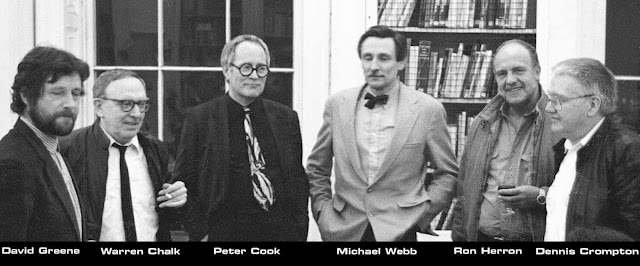Archigram and the Axonometric
Archigram was an avant-garde architectural group formed in the 1960s - based at the Architectural Association, London - that was neofuturistic, anti-heroic and pro-consumerist, drawing inspiration from technology in order to create a new reality that was solely expressed through hypothetical projects. The main members of the group were Peter Cook, Warren Chalk, Ron Herron, Dennis Crompton, Michael Webb and David Greene. Designer Theo Crosby was the "hidden hand" behind the group. He gave them coverage in Architectural Design magazine (where he was an editor from 1953–62), brought them to the attention of the Institute of Contemporary Arts (ICA) in London, where, in 1963, they mounted an exhibition called Living Cities, and in 1964 brought them into the Taylor Woodrow Design Group, which he headed, to take on experimental projects
"A giant city crawls across the land like an insect. Airships drop cultural attractions onto unsuspecting villages. A hovercraft expands into an inflatable settlement. These visions, sparked by sci-fi novels and comic books, belonged to the collective Archigram, which existed from 1961 to 1974."
The Plug-in-City, 1964

Plug-in City was designed to encourage change through obsolescence: each building outcrop is removable, and a permanent “craneway” facilitates continual rebuilding. Between 1960 and 1974, Archigram published nine provocative issues of its magazine and created more than nine hundred exuberant drawings illustrating imaginary architectural projects ranging in inspiration from technological developments to counterculture, from space travel to science fiction. The group’s work opposed the period’s functionalist ethos; Archigram designed nomadic alternatives to traditional ways of living, including wearable houses and walking cities—mobile, flexible, impermanent architecture that they hoped would be liberating.
Gallery label from 9 + 1 Ways of Being Political: 50 Years of Political Stances in Architecture and Urban Design, September 12, 2012–March 25, 2013.
Archigram's architectural explorations can be thought of as architecture without architecture (this is the title of a book on archigram by Simon Sadler than you can read here), this summation speaks to a tendency to reject the permanency of architecture and to their reputation as a generator of architectural ideas, rather than architecture.
Axonometric drawings allowed Archigram to present their drawings in such a way that referenced reality whilst stripping away the perspective and proportion that we associate with reality. This creates a scene where the drawings are seen as a commentary on reality rather than a proposal for it. This allows for the proliferation of ideas and discussion without having to detail or resolve all elements - it distils the essence of the idea.
The Walking City, 1964
Traversing the ocean, the units of Herron's Walking City represent a kind of technological utopianism—military submarines are combined with insectlike exoskeletons and periscoping legs. Each unit of the city contains a comprehensive set of urban resources. Linked by a superstructure of retractable corridors, they form an instant and itinerant metropolis. Here collage is used both to circulate an idea and to propose a new architecture of circulation: Herron’s work was disseminated through small magazines as image–based virtual architecture; the surreal elements of collage—simultaneous viewpoints, depth, and flatness—are instrumental to proposing a city that not only walks but adapts to endless change.
Architectural Assemblage to Collage City, July 10–December 1, 2013.
The role of axonometric drawings is less apparent in the Walking City drawings. The drawing is layered with a a range of elevation, axonometric and perspective elements to create a distorted collage that speaks to the constantly evolving nature of the architectural proposal.





Comments
Post a Comment